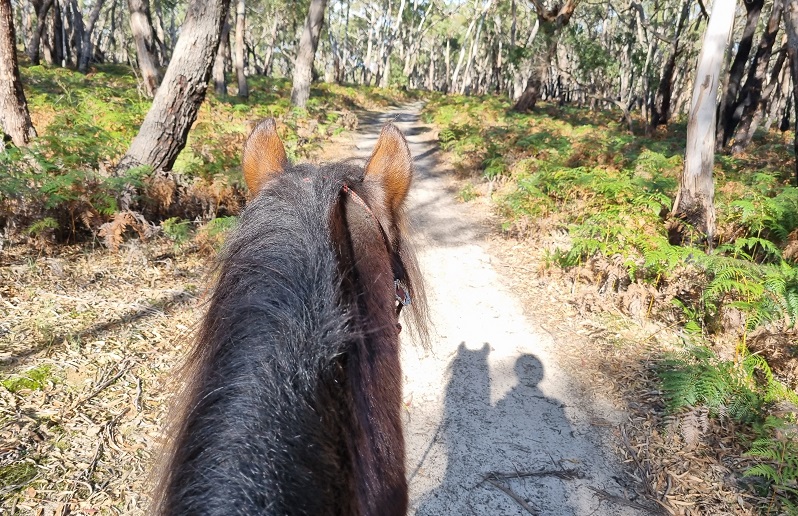Thoughts on teaching and learning while riding Rev
#Rev #education

Rev. What a different horse he is now. Of course he is older and maybe he was a bit sluggish because he’d tipped his water container over overnight and he had a big drink before the ride. He was definitely in a very mellow mood and not in a hurry today.
I have never before had him stay in a decent toelt and then a calm canter (when asked) out on a ride on a completely loose rein, and then slow down when I asked him with voice and breathing out and relaxing my seat. On the way home, he was a bit quicker, but still managed a walk home on a long rein. That was never possible before.
A fleeting thought while I luxuriated in the feeling of Rev listening to very small requests I made…. Related to teaching others to ride and reflecting on my own long journey. Aside from considering how well horses understand things that we oftentimes don’t give them credit for understanding, but instead try to “drill” new things into them. There is also the issue that we often ask too much, ask too soon, and don’t stop asking when we get what we ask, leaving a horse confused, only to then call it stupid and ask with more force.
Looking at it from a purely mechanical point of view, it is amazing to see just how subtle some signals can be and can be well understood if the rider is precise in asking, release and praise. The danger of being self-taught is never finding out how subtle we can be in our requests. If we don’t know that a small rotation of the hip, tensing a muscle in the leg, a tiny lift of the rein hand can request a turn, then we will probably pull on the rein instead. If nothing else because it is seen everywhere.
I guess that is also the danger of learning from the wrong teachers. And this consideration came out of the thought that as a teacher, how hard it is to convince someone to ask with little and wait for the response, when at the start, the beginner doesn’t know how to ask, and doesn’t know what the response should be. How easy it is to succumb to doing more, asking with too much force, to get a response. How a student has to trust his teacher to follow the instructions when at the start the student doesn’t have the feeling, the body awareness, the balance or any of the contextual knowledge to ask correctly. It is certainly easy to see how, in order to give a student a quick success feeling, to justify a lesson’s outcome, a teacher might accept, condone or even encourage unsubtle or rough requests. Or how the self-taught person, in his/her ignorance would ask too roughly to get a response. Likewise how a self-taught person might ask kindly or subtly but not quite the right way due to ignorance, lack of knowledge, then not wait for the right response and give up and resort to a more loud request and so have the same outcome.
To teach well, it is therefore important that the student is not in a hurry, and is willing to listen to both the teacher and the horse. It is important to have a horse that knows how to respond to subtle aids, so that it reacts correctly when the student asks correctly, but also doesn’t get flustered or bothered when the student loses balance or is inadvertently a little too rough. And to have a teacher who will firstly have the horse’s welfare in mind, and who will set up the student and the horse for success so that both can have positive experiences from each session and look forward to the next one. The teacher will need to understand the difficulties the student has in finding balance and body awareness and give the student the time he needs and the challenges he needs to improve. And to impress on the student the need for subtlety and to listen to the horse and have the patience to see if the request came across well.
But there is a lot of faith the student has to have in the teacher, that the things that initially don’t make sense will make sense some day, that the movements in the saddle will eventually yield the desired results, and that eventually, the time invested in doing this thing slowly will bear fruits.
There is also a lot of faith the teacher places in the student, for example that there is a genuine passion for good horsemanship, and an ongoing, sustained commitment to pursue the goal of becoming a horseman. And that the student is willing to listen to instructions, treats the horse fairly and resists the urge to hurry the process.
